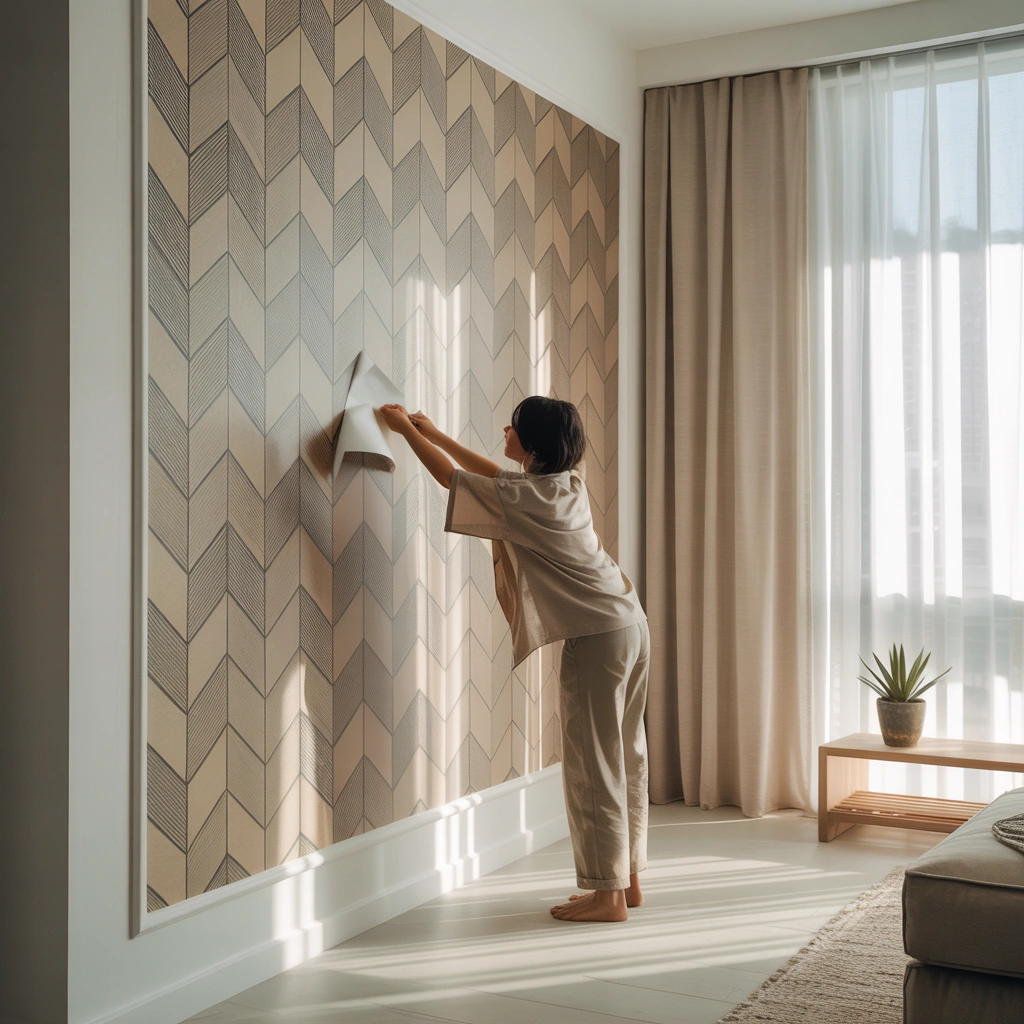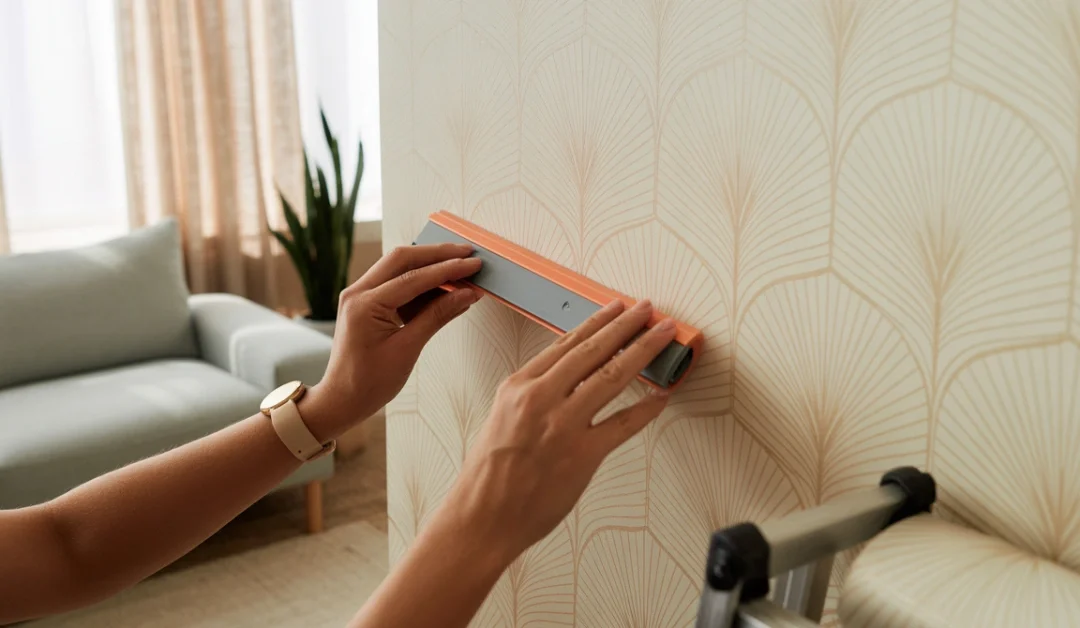Is hanging wallpaper hard? Not anymore! With the right steps, even a beginner can make walls look like a pro did them. DIY wallpapering saves money, lets you pick fun designs, and turns boring rooms into happy spaces.
Can I Achieve a Professional Look Without Hiring Help?
Yes! Many people think only experts can do this, but tools and guides today make it easy. Just follow the steps, take your time, and avoid mistakes like bubbles or crooked patterns.
1. What Tools and Materials Do I Need to Install Wallpaper?
What Are the Essential Tools for Installing Wallpaper at Home?

To get started, these tools will be needed:
- Measuring tape: To know how much wallpaper to buy.
- Level or plumb line: To keep strips straight.
- Smoothing brush or squeegee: To push out bubbles.
- Utility knife: To cut extra wallpaper.
- Bucket: For mixing paste, if using traditional wallpaper.
- Drop cloth: To protect floors from glue or mess.
- Paint roller: For applying adhesive to large areas.
Each tool has a job. For example, a plumb line (a string with a weight) draws a straight vertical line on the wall, so the first strip of wallpaper isn’t crooked. A smoothing brush pushes air bubbles toward the edges, leaving a flat finish.
How Do I Choose the Right Type of Wallpaper?
Two main types are used:
- Peel and stick: Easy for beginners—just peel the back and press on the wall.
- Traditional: Needs glue, but lasts longer.
Pro tip: If unsure, check out grass cloth vs. peel and stick wallpaper to pick what’s best for your room.
Are There Any Optional but Helpful Accessories I Should Have?
Yes! These extras make the job easier:
- Corner roller: For tight spaces like corners or around outlets.
- Wallpaper smoother with built-in bubble popper: Saves time by combining two tools.
- Spray bottle: For misting water on traditional wallpaper to soften glue.
2. How Do I Prepare My Walls for Wallpaper Installation?
How Important Is Wall Cleaning Before Applying Wallpaper?
Very! Dust, dirt, or grease stops wallpaper from sticking. Wipe walls with a damp cloth first. For greasy spots, use a mild detergent.
What Should I Do About Cracks or Holes?
Fill them with spackle (a kind of wall putty) and sand them smooth. This makes the wallpaper look flat and neat.
- Step 1: Apply spackle with a putty knife.
- Step 2: Let it dry (usually 1–2 hours).
- Step 3: Sand with fine-grit sandpaper until smooth.
Tip: For large holes, use mesh drywall tape under the spackle for extra strength.
Do I Need to Prime My Walls Before Wallpapering?
Yes, if the walls are drywall or have old paint. Primer helps the wallpaper stick better.
Primer Types:
- Oil-based: Best for sealing porous surfaces.
- Water-based: Easier to clean up, but dries faster.
Apply primer with a paint roller, and let it dry completely (usually 24 hours).
3. How Do I Install Peel and Stick Wallpaper Step by Step?
How Does Peel and Stick Wallpaper Work?

It has a sticky backing that activates when peeled off. No glue needed! Just stick it to the wall.
Where Should I Start When Hanging the First Strip?
Begin at a corner or near a window. Use a plumb line (a string with a weight) to draw a straight vertical line. This keeps the first strip straight.
How Do I Match Patterns and Avoid Misalignment?
Look at the pattern on the wallpaper roll. Line up the design with the strip next to it. Small adjustments can be made before pressing it down.
- Step 1: Hold the strip against the wall, aligning the top edge with the ceiling.
- Step 2: Slide it left or right to match the pattern with the previous strip.
- Step 3: Press the top half first, then work your way down.
What’s the Best Way to Smooth Bubbles and Trim Edges?
Use a smoothing brush to push bubbles toward the edges. For corners or outlets, cut a small X with a utility knife and fold the wallpaper around them.
Trimming tips:
- Cut edges slowly to avoid tearing the paper.
- Use a ruler to keep cuts straight.
4. What Are the Most Common Wallpaper Installation Mistakes to Avoid?
Why Shouldn’t I Skip Wall Preparation?
Skipping steps like cleaning or priming makes the wallpaper peel off faster. Good prep = longer-lasting results.
What Happens If I Ignore the Plumb Line?
Walls might look crooked. A plumb line ensures everything is straight, even if the room isn’t perfect.
Why Is Stretching or Overlapping Wallpaper a Bad Idea?
Stretching causes wrinkles. Overlapping hides patterns and creates thick lines. Always leave a tiny gap (1/8 inch) between strips.
Improper Seaming and Overlapping
If strips are too close, seams show. If they overlap, the wallpaper looks messy. Use a seam roller to press edges together neatly.
Using the Wrong Tools or Rushing the Job
Rushing leads to mistakes. Take breaks to avoid fatigue. Use the right tools, like a corner roller for tight spots.
5. How Can I Remove Wallpaper Safely Without Damaging My Walls?
How Do I Remove Traditional vs. Peel and Stick Wallpaper?
- Peel and stick: Start at a corner and slowly pull it off.
- Traditional: Spray water mixed with fabric softener, wait 10 minutes, then scrape it off gently.
Extra help: For more tips, visit removing wallpaper safely.
How Can I Protect My Drywall During Removal?
Avoid sharp tools that scratch the wall. For traditional wallpaper, use a scoring tool to poke holes in the paper, letting water penetrate faster.
What’s the Best Way to Clean Adhesive Residue After Removal?
For peel and stick: Wipe with a damp cloth. For stubborn glue, use a commercial adhesive remover.
6. What Pro Tips Will Help Me Achieve a Flawless Finish?
Should I Install Wallpaper One Room at a Time?
Yes! Focus on one wall at a time. This lets you fix mistakes before moving to the next.
How Does Lighting Affect the Outcome?
Bad lighting hides errors during installation. Work near windows or use bright lamps to spot bubbles or misaligned patterns.
How Do I Handle Corners, Outlets, and Tricky Spots?
- Corners: Use a corner roller to press wallpaper into tight angles.
- Outlets: Turn off the electricity, remove the cover plate, and cut an X around the outlet. Fold the edges behind the plate.
Why Is Pattern Alignment So Important?
Mismatched patterns look messy. Take time to line up designs, even if it means trimming strips.
7. Frequently Asked Questions About Wallpaper Installation
Yes, especially if the walls are unpainted or uneven.
No—remove old wallpaper first. The new paper won’t stick well otherwise.
Use a small brush to apply glue under the edges, then press them down.
Avoid using it in bathrooms or kitchens unless it’s labeled “humidity-resistant.”
A small room takes 2–4 hours, depending on experience.

